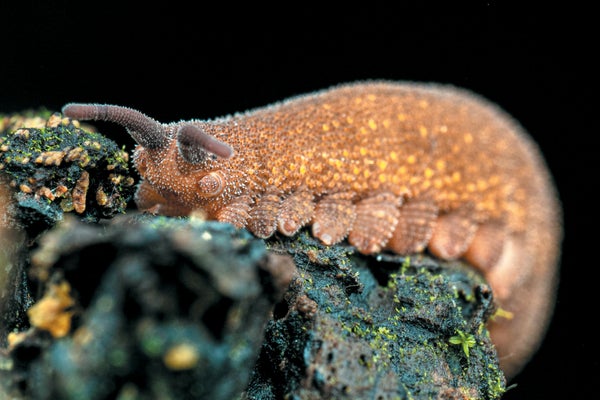June 5, 2025
3 min read
The velvet worm’s extraordinary goo could inspire recyclable bioplastics

Velvet worms like this one “sneeze” out a sticky goo with intriguing properties.
The velvet worm, a squishy little predator that looks like the stretch-limo version of a caterpillar, has a whimsical MO: it administers death by Silly String.
In the leaf litter of tropical and temperate forests around the world, velvet worms stalk the night on dozens of stubby legs. The pocket-size predator—whose species range from less than half an inch to eight inches long—can barely see, so it bumbles around, hoping to literally bump into an edible bug such as a cricket or a woodlouse. When it finds one, the velvet worm uses nozzles on either side of its face to shoot jets of sticky slime at its victim.
“It happens so fast it’s almost like they’re sneezing,” says Matthew Harrington, a biochemist at McGill University who has studied velvet worms for a decade.
On supporting science journalism
If you’re enjoying this article, consider supporting our award-winning journalism by subscribing. By purchasing a subscription you are helping to ensure the future of impactful stories about the discoveries and ideas shaping our world today.
At first, the goo is a watery liquid, but in midair it transforms into jellylike ropes that ensnare the unlucky creature and stick it to the ground. As the prey struggles, the slime forms fibrous threads, and within seconds the substance hardens into a glasslike solid.
Scientists have been intrigued by velvet worm slime’s adhesive properties for more than a century. (In the 1870s researchers puzzling over what makes it stick tried tasting it. The verdict: bitter.) Recent findings suggest the phase-shifting goo could inspire a new generation of recyclable bioplastics, according to research published by Harrington and his colleagues in the Proceedings of the National Academy of Sciences USA.
Previously, the researchers discovered that soaking the hardened fibers in water returned them to their liquid state—and by rubbing the resultant mess between their fingertips, they could get fibers as strong as nylon to re-form. That means “everything we need to know about making these fibers is encoded in the proteins themselves,” Harrington says.
But isolating those proteins is easier said than done, the scientists found. The slime is so sensitive to touch that even standard laboratory techniques such as pipetting can trigger its phase shift. To avoid that sticky situation altogether, the scientists sequenced the RNA of proteins from the slime of velvet worms collected in Barbados, Singapore and Australia. Then they fed the RNA sequences into AlphaFold3, a program that uses artificial intelligence to predict protein shapes. For all three species, it “spit out this horseshoe shape” rich in the amino acid leucine, Harrington says.
Although this structure is novel to materials scientists, it’s old hat to evolution. A similar protein called a toll-like receptor is part of an ancient immune system feature found across plants, invertebrates and vertebrates. These receptors sit on the surface of immune cells, binding tightly to pieces of invading microbes and releasing them later. Harrington and his team suggest the horseshoe-shaped protein may use a similar “host-guest” dynamic to grab onto other proteins in the slime, binding strongly but reversibly to form the powerful fibers. Those are magic words to materials scientists working on developing replacements for plastic that can be broken down easily and re-formed into new shapes.
These horseshoe proteins are a significant find, says Yendry Corrales Ureña, a researcher at Costa Rica’s National Laboratory of Nanotechnology who studies velvet worm slime but wasn’t involved in the study. She adds, however, that these proteins don’t account for important properties of the slime such as its toughness or elasticity. “They are just one piece of the larger puzzle.”
Julian Monge Najera, an ecologist at the University of Costa Rica who researches invertebrate evolution, says the fact that three velvet worm species from different continents have the same protein shape in their slime underscores how incredibly ancient velvet worms are and how long ago their chemical R&D must have occurred.
The fossil record shows that velvet worms have existed almost exactly as they do now for at least 300 million years, predating both dinosaurs and today’s continents. “If I could go back in a time machine, the velvet worms I would catch in the post-Cambrian period would be identical to the ones in Costa Rica’s cloud forests today,” Monge Najera says—phase-shifting slime and all.
Harrington and his team are working to purify the horseshoe protein from the slime and confirm its structure via electron microscopy. “We won’t be milking velvet worms for slime to replace plastics,” Harrington says. “But we hope to copy their chemical tricks.”
